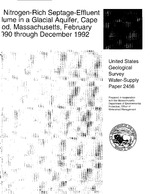Physical, chemical, and microbial processes controlled transport of a nitrogen-rich ground-water plume through a glacial aquifer. Lithologic heterogeneity and vertical head gradients influenced plume movement and geometry. Nitrate was the predominant nitrogen form and oxygen was depleted in the ground-water plume. However, denitrification transformed only 2 percent of plume nitrogen because of limited organic-carbon availability. Aerobic respiration, nitrification and cation exchange (unsaturated zone) and ammonium sorption (saturated zone) had larger effects.


